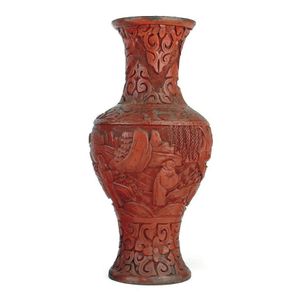19th Century Qing Dynasty Cinnabar Vase
You must be a subscriber, and be logged in to view price and dealer details.
Subscribe Now to view actual auction price for this item
When you subscribe, you have the option of setting the currency in which to display prices to $Au, $US, $NZ or Stg.
- Cinnabar - Cinnabar is an intense deep red colouring agent that has been in use for thousands of years, derived from crystalised red mercuric suphide. It is made into a coating by grinding ore into a fine powder then mixing the powder with lacquer made from the sap of the Rhus tree, which grows in East Asia.
As applied to Oriental antiques, cinnabar refers to successive layers of laquer applied to the metal base of an object. Once the coating has dried and hardened, a further layer is applied. The layers continue to be applied until the thickness is 3 to 6 mm, and this may take up to 200 to 300 coats. At this stage, the surface is ready for the carving, that is characteristic of cinnabar items.
Because of the labour required, cinnabar items are usually small, such as vases, boxes, trays and snuff bottles.
However buyers should be aware that the cinnabar technique has been copied using modern plastic type materials that are moulded rather than carved. A close examination of a genuine cinnabar item under a strong magnifying glass or jewellers loupe should show evidence of the many layers that make up its thickness, and possibly tool marks left by the carver. - Qing Dynasty - The Qing Dynasty was the last imperial dynasty of China, ruling from 1644 to 1912. It was established by the Manchu people, who originated from the northeastern region of China. The Qing Dynasty was preceded by the Ming Dynasty and followed by the Republic of China.
- Arabesque - The arabesque pattern is an ornamental design that features flowing, curving lines and elaborate geometric shapes. It is inspired by the art and architecture of the Islamic world and was developed at Fontainebleu France in the mid 16th century. Its use was spread through published engravings, and it is characterized by its intricate and highly decorative nature. The arabesque pattern is created using a repetitive motif that is repeated and interwoven to create a cohesive design. It was used as a form of decoration in art, architecture, textiles, pottery, furniture and ceramics and it is often used to add a sense of grandeur and sophistication to a design. The arabesque pattern is admired for its beauty and complexity, and it continues to be used in a wide range of decorative contexts today.
- Ming Dynasty - The Ming Dynasty was a ruling dynasty of China from 1368 to 1644. It succeeded the Yuan Dynasty and preceded the Qing Dynasty. The Ming Dynasty was established by Zhu Yuanzhang, a former Buddhist monk who became a rebel leader and eventually overthrew the Mongol Yuan Dynasty. During the Ming Dynasty, China experienced a period of relative stability and prosperity. The government was centralized and bureaucratic, with the emperor at the top of the hierarchy. The Ming Dynasty is known for its cultural achievements, including the development of porcelain, the invention of movable type printing, and the construction of the Great Wall of China.
- Diaper Motif - The diaper motif is a repeating geometric pattern in decorative arts that consists of small diamond or lozenge shapes arranged in a grid. The pattern is often used as a background or border on textiles, ceramics, metalwork, and other decorative items. It can be found in a variety of cultures and historical periods, and is often used in formal or ornamental designs. The name "diaper" comes from the pattern's resemblance to the criss-crossed fabric of a baby's diaper.
This item has been included into following indexes:
Visually similar items

An old Chinese cinnabar lacquer vase, baluster form, black lacquer to the interior, character marks in gilt to the base. Height 19 cm

A red cinnabar vase, the baluster vase with a trumpet neck profusely carved throughout with a figural narrative scene in a garden and sublime landscape setting to the body between fret, lappet and stiff leaf borders and flora upon a diaper ground, height 2

Russian enamel vase, of tapering form, decorated with raised enamel work in the form of flowers in tones of red, white and blue, height 9.4 cm

A Chinese red Laquer vase, on stand. Height 21 cm
